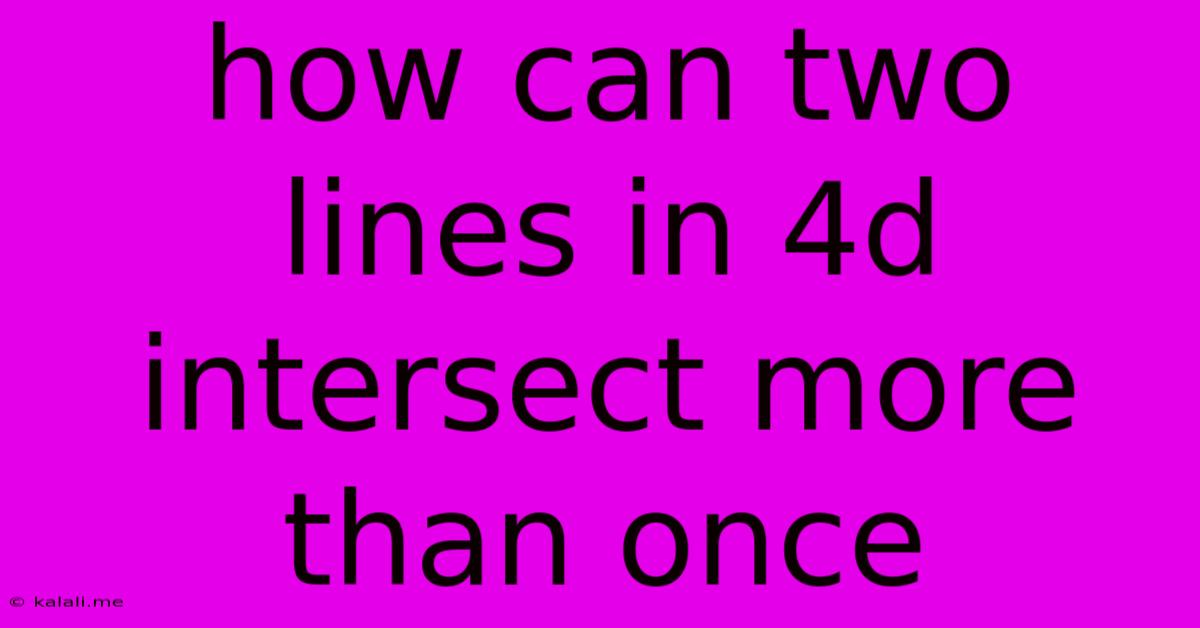How Can Two Lines In 4d Intersect More Than Once
Kalali
Jun 01, 2025 · 3 min read

Table of Contents
How Can Two Lines in 4D Intersect More Than Once?
This article explores the fascinating concept of lines intersecting more than once in four-dimensional space. Understanding this requires moving beyond our intuitive three-dimensional understanding of geometry. In 3D space, two distinct lines can intersect at most once or be parallel. However, the added dimension of 4D space allows for more complex geometrical relationships.
The Intricacies of Higher Dimensions
Our everyday experience limits our understanding of higher dimensions. We visualize lines and planes easily in 3D, but visualizing 4D objects requires abstract thought. Imagine a line in 3D space. It has one degree of freedom – you can only move along its length. Now, consider a plane in 3D space. It has two degrees of freedom – you can move in two independent directions within the plane.
In 4D space, we can have a "hyperplane" which has three degrees of freedom, and a line which, as before, has one. The key to understanding multiple intersections lies in the nature of these higher-dimensional objects.
Multiple Intersections: A 4D Perspective
The possibility of multiple intersections arises from the fact that in 4D space, two lines can "skew" in a way that's impossible in 3D. In 3D, if two lines aren't parallel, they must intersect. However, in 4D, two lines can be non-parallel yet not intersect. This is because they might "miss" each other in the fourth dimension.
Think of it this way: Imagine two ships sailing on the ocean (a 2D surface). They can cross paths. Now, imagine two airplanes flying at different altitudes. They may fly parallel to each other, never intersecting, or they might cross paths at different points. In 4D space, two lines can "miss" each other in a similar way across the fourth dimension, yet they can still intersect multiple times if their trajectories are carefully designed to do so.
Visualizing the Concept
While direct visualization is challenging, we can use analogies to understand the concept. Consider projecting a 4D object into 3D space. Just as a 3D cube projected onto a 2D plane results in overlapping lines and shapes, projecting 4D intersecting lines into 3D might show lines that appear to intersect multiple times or in seemingly impossible ways.
Mathematical Representation
The concept can be elegantly described using linear algebra. A line in 4D space can be represented by a set of parametric equations involving four variables. Multiple intersections occur when these equations have more than one solution. The specific conditions for multiple intersections involve the relationship between the direction vectors and position vectors of the two lines in 4D space. This requires a deeper dive into linear algebra and vector calculus.
Beyond Intersections: Implications in Higher Dimensions
The possibility of multiple intersections between lines in 4D is not just a mathematical curiosity; it has implications for understanding higher-dimensional geometry and its applications in various fields. For example, it plays a role in advanced areas of physics and computer graphics when dealing with complex simulations and visualizations of higher dimensional spaces.
In conclusion, the ability of two lines to intersect more than once in 4D space highlights the non-intuitive nature of higher dimensions. While direct visualization is difficult, mathematical tools and analogies can help us comprehend this fascinating aspect of higher-dimensional geometry. The understanding of such concepts opens doors to exploring more complex mathematical structures and their applications in various scientific domains.
Latest Posts
Latest Posts
-
Could Not Resolve Host Mirrorlist Centos Org Unknown Error
Jun 03, 2025
-
What You Up To Or Too
Jun 03, 2025
-
What Is This And Some Hole
Jun 03, 2025
-
How To Find Line Integral With Respect To Arc Lenth
Jun 03, 2025
-
Does A Magnet Work In Space
Jun 03, 2025
Related Post
Thank you for visiting our website which covers about How Can Two Lines In 4d Intersect More Than Once . We hope the information provided has been useful to you. Feel free to contact us if you have any questions or need further assistance. See you next time and don't miss to bookmark.